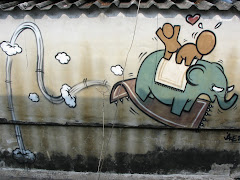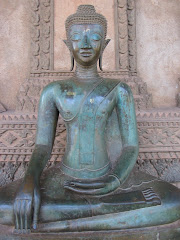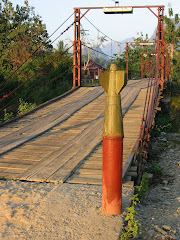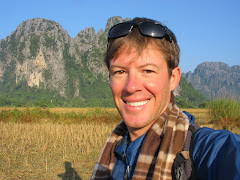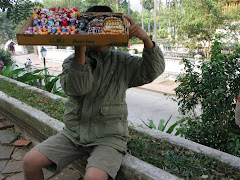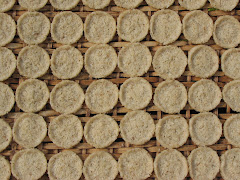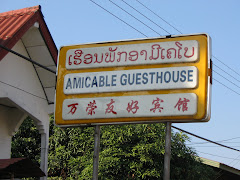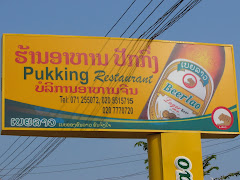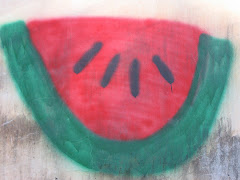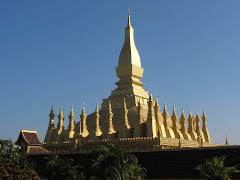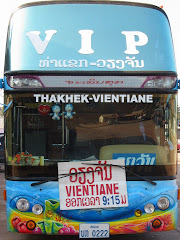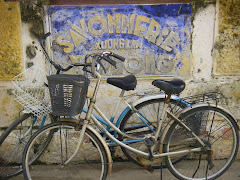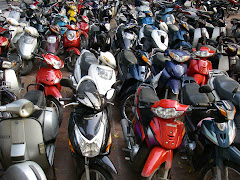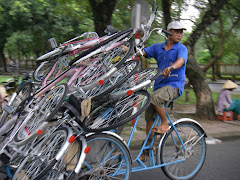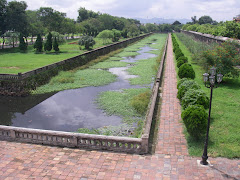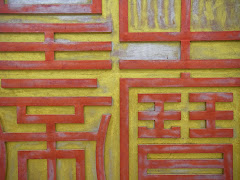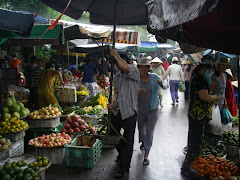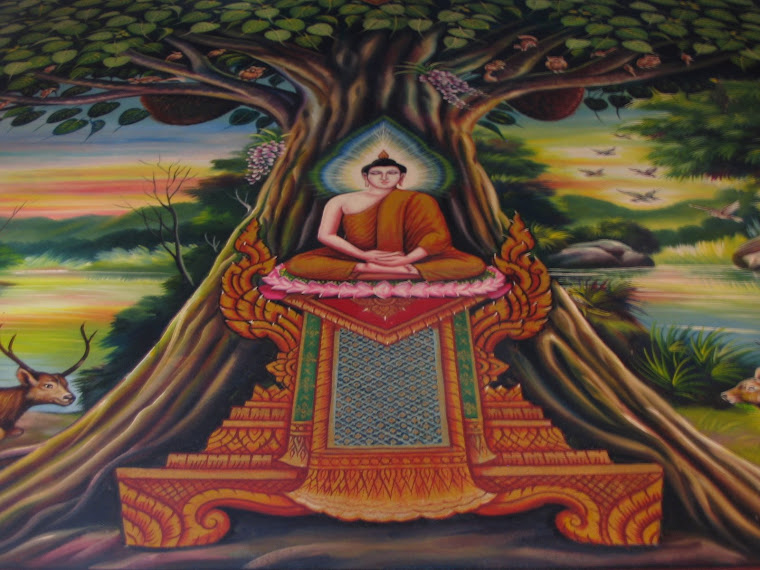
One of the very first things you realize when attempting to negotiate the highways and byways of Vietnam is that, in order to avoid becoming just another piece of road kill, you've got to behave like the locals. That, of course, means chucking every "westernized" notion of proper roadway behavior that you've ever learned and diving headlong, and confidently, into the motorized fray. While traffic rules apparently exist (why else would they have traffic cops loitering on street corners?) they seem to be rarely, if ever, enforced. So where does that leave the hapless visitor? A good start would be dropping your common sense at the curb and adopting the local customs:
(1) Realize that NO ONE will observe the sanctity of the crosswalk, not even the little old ladies pedaling their mobile flower stalls. With traffic racing around you in not two, but possibly three or four directions, it would be suicidal to try and outrun passing vehicles. You must walk as slow as possible - I mean glacially slow - through the crosswalks. Oh no, the cars and motorbikes will not stop for you, in fact, they'll probably speed up. But they will SEE you and, if at all possible, avoid running you down. By moving one half-step at a time, you (hopefully) give them ample time to adjust their course. I admit, it's a little scary to stand in the midst of a sea of speeding steel, screaming engines, and blaring horns - and you will feel a little silly doing your best snail impersonation in the middle of Ho Chi Minh Blvd. - but to sprint is only asking for total destruction.
(2) Don't be ashamed to use other vehicles (cars, scooters, bikes, rickshaws, or strollers) or pedestrians (especially the elderly or women with infant children) as a buffer between yourself and oncoming traffic. Yeah, your sense of manliness may take a beating, but it's nothing compared to the beating you'd take by a runaway motorbike loaded down with 500 lbs. of poultry or 15 vertical feet of wicker fishtraps. Seriously, suck up your ego and hide behind the old people.
(3) When riding a bike or motorscooter of your own, just assume that everyone around you is a MUCH better driver than you are. Trust me, they are. For good measure, why not assume that they are actively trying to avoid plowing into you from behind. They may not be - in fact they may not even notice you as they drive and (a) try to light their cigarette (b) chat with their passengers (c) text message (d) attempt to restrain whatever sort of animal(s) they are taking to market, or (e) hustle for tourists - but ignorance is indeed bliss, even if it is intentional ignorance. Just proceed at your own pace and hope for the best.
(4) USE YOUR HORN....LOUDLY and OFTEN. I've never understood the insanely incessant use of horns on the streets of the developing world. It always seemed to me that drivers were just attempting to auditorially torture everyone within earshot for some sick, twisted, and unexplained reason. However, after a stint on those same roads, in my own vehicle, this behavior has begun to make sense. Perfect sense, in fact. Assuming that traffic laws mean nothing- including rules for passing, lane changes, turning, etc - how do you signal your presence and intended behavior to your fellow drivers? You honk like a friggin mad man. Honking lets everyone know you're there and coming on fast. Another benefit of the horns is that, after a while, you learn to tell exactly what sort of vehicle is coming up on you - allowing you to plan your response accordingly: booming, low pitched horn is a city bus, dump truck, or army tank - get the hell out of the way; mid-range pitch, often gussied up with a dial-tone like song snippet is probably an SUV and deserves your respect - move off to the side of road, but don't slow down; high-pitched horn that sounds like a bleating sheep, that's just another scooter - fight off his advances and hold your ground; and finally, that little bike bell you hear tinkling behind you, probably just an old man being a smart ass - swerve in front of him and show him who's boss.
(5) Finally, when all else fails, just play the clueless foreigner card. So far, I've found that most traffic-related difficulties and potential confrontations can be easily dealt with by pulling out my laminated Hanoi city map, staring at it intently for a few moments, staring up at the nearby steet signs (printed in Vietnamese, of course), staring again at the map, flipping the map around, and repeating the act...er, I mean process. Works like a charm.
***Although I certainly don't subscribe this little nugget of sage advice, I feel it should be included to reflect a local's take. This is from Ahn, the man I rented my motorbike from:
Ahn: "And remember, sometime chicken and dog cross the road and get in way. If that happen, just hit them, ok. Don't stop. Keep going."
Me: "Are you serious? Just keep going?"
Ahn: "Oh yeah, there are many, many chickens in the countryside and they will not miss one."
Me: "But what if I hit a dog?"
With a completely straight face and deadpan tone, Ahn replies "The family probably want new puppy anyway."
 It's hard to believe that I've come to the end of my Vietnam adventure already. The last six weeks have taken me - via motorbike, train, boat, and bus - from Lai Chau and Sapa near the Chinese border in the north to Chau Doc, a small Mekong Delta town just a few river miles from the Cambodian border in the south. Although I doubt the differences between Vietnam and Cambodia will be overwhelming (the Delta was Cambodia for hundreds of years, after all) I'm trying parti
It's hard to believe that I've come to the end of my Vietnam adventure already. The last six weeks have taken me - via motorbike, train, boat, and bus - from Lai Chau and Sapa near the Chinese border in the north to Chau Doc, a small Mekong Delta town just a few river miles from the Cambodian border in the south. Although I doubt the differences between Vietnam and Cambodia will be overwhelming (the Delta was Cambodia for hundreds of years, after all) I'm trying parti cularly hard to enjoy my last full day in the country. Chau Doc has turned out to be yet another wonderfully mellow riverside town filled with more of the friendly southerners I've grown accustomed to since leaving Saigon. Although it's seen a fair share of misery over the years (mostly due to the Khmer Rouge), you'd never know it after a casual look around. I've spent the better part of two days wandering the streets and surrounding countryside and meeting a handful of locals - including Thuan,
cularly hard to enjoy my last full day in the country. Chau Doc has turned out to be yet another wonderfully mellow riverside town filled with more of the friendly southerners I've grown accustomed to since leaving Saigon. Although it's seen a fair share of misery over the years (mostly due to the Khmer Rouge), you'd never know it after a casual look around. I've spent the better part of two days wandering the streets and surrounding countryside and meeting a handful of locals - including Thuan,  the 15 year old wonderkid from Cambodia who dragged me all over nearby Sam Mountain this morning. Although it's an out of the way sort of place, Chau Doc serves as a jumping off spot for river traffic into Cambodia. Word on the street is that crossing the border is fairly straight forward, if you don't mind paying a bribe or two to the corrupt Cambodian officials wielding the visa stamps. If all goes well, I'll be lining their pockets a bit by 10am tomorrow before heading into Phnom Penh to begin the next leg of the journey.
the 15 year old wonderkid from Cambodia who dragged me all over nearby Sam Mountain this morning. Although it's an out of the way sort of place, Chau Doc serves as a jumping off spot for river traffic into Cambodia. Word on the street is that crossing the border is fairly straight forward, if you don't mind paying a bribe or two to the corrupt Cambodian officials wielding the visa stamps. If all goes well, I'll be lining their pockets a bit by 10am tomorrow before heading into Phnom Penh to begin the next leg of the journey. 


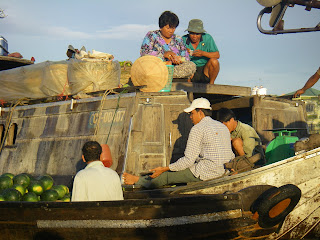





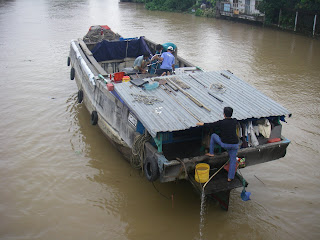



 Catholic (second - thank the French) country, it is also home to the Cao Dai religion. It was founded in the Mekong Delta region by a mystic named Ngo Mihn Chieu in 1926 and, to put it simplistically, is a blend of "Buddhism, Confucianism, Taoism, native Vietnamese spiritualism, Christianity, and Islam." Among the more interesting aspects of the religion is belief that the spirits of Joan of Arc, Shakespeare, Lenin, and Victor Hugo can be contacted via seances in order to guide the living. Followers wear all white, are vegetarians, practice daily meditation, and attend prayers at the Cao Dai temple four times
Catholic (second - thank the French) country, it is also home to the Cao Dai religion. It was founded in the Mekong Delta region by a mystic named Ngo Mihn Chieu in 1926 and, to put it simplistically, is a blend of "Buddhism, Confucianism, Taoism, native Vietnamese spiritualism, Christianity, and Islam." Among the more interesting aspects of the religion is belief that the spirits of Joan of Arc, Shakespeare, Lenin, and Victor Hugo can be contacted via seances in order to guide the living. Followers wear all white, are vegetarians, practice daily meditation, and attend prayers at the Cao Dai temple four times 
















 Approaching the riverside fish/vegetable market, I could see that it was also knee deep in water and still as busy as ever. Against the steady hum of a hundred Vietnamese conversations, women continued selling vegetables on table tops literally only an inch or t
Approaching the riverside fish/vegetable market, I could see that it was also knee deep in water and still as busy as ever. Against the steady hum of a hundred Vietnamese conversations, women continued selling vegetables on table tops literally only an inch or t

 Sorry, but I can't hear "Da Nang" without picturing Robin Williams in the movie Good Morning Vietnam as he belts out the (slightly twisted) Elvis lines "Ohhhh Viva Da Nang! Danang me Danang me, why don't you get a rope and haaaang meeeee?"
Sorry, but I can't hear "Da Nang" without picturing Robin Williams in the movie Good Morning Vietnam as he belts out the (slightly twisted) Elvis lines "Ohhhh Viva Da Nang! Danang me Danang me, why don't you get a rope and haaaang meeeee?" With more than a little trepidation, I did something that I've always sworn off in the past (with one regretable exception in China): I signed up for an organized "tour." I'll be blunt, I f***ing hate organized tours - and yes, I am completely aware of the irony. For the past 14 years or so, I've made my living leading organized tours down rivers. That's probably part of the problem. I just can't handle not being in the driver's seat, so to speak. And I hate being just another tourist, herded from one sight to the next. I repeat: I am completely aware of the irony. And it hurts.
With more than a little trepidation, I did something that I've always sworn off in the past (with one regretable exception in China): I signed up for an organized "tour." I'll be blunt, I f***ing hate organized tours - and yes, I am completely aware of the irony. For the past 14 years or so, I've made my living leading organized tours down rivers. That's probably part of the problem. I just can't handle not being in the driver's seat, so to speak. And I hate being just another tourist, herded from one sight to the next. I repeat: I am completely aware of the irony. And it hurts.
 Rolling out of Hanoi's Ga Hang Co train station, I found myself alone in my four-bunk "soft-sleeper" compartment. Guessing I must have settled into the wrong berth, I wandered up and down the coach looking for someone official to talk to. A quick check with a uniformed guy half-heartedly cleaning the car's bathroom confirmed that I was in the right place. Based on previous developing-world-train-adventures (think India) I just assumed I'd be sharing second hand cigarette smoke and fighting for elbow room with drunk travel mates, all the while dodging flying hot noodle soup...at least for the first few hours. Not this time around, apparently. For the next 13 hours, I shared the entire train car with a grand total of three other travelers and one persistent s.o.b. of a mouse. Perfect.
Rolling out of Hanoi's Ga Hang Co train station, I found myself alone in my four-bunk "soft-sleeper" compartment. Guessing I must have settled into the wrong berth, I wandered up and down the coach looking for someone official to talk to. A quick check with a uniformed guy half-heartedly cleaning the car's bathroom confirmed that I was in the right place. Based on previous developing-world-train-adventures (think India) I just assumed I'd be sharing second hand cigarette smoke and fighting for elbow room with drunk travel mates, all the while dodging flying hot noodle soup...at least for the first few hours. Not this time around, apparently. For the next 13 hours, I shared the entire train car with a grand total of three other travelers and one persistent s.o.b. of a mouse. Perfect.





